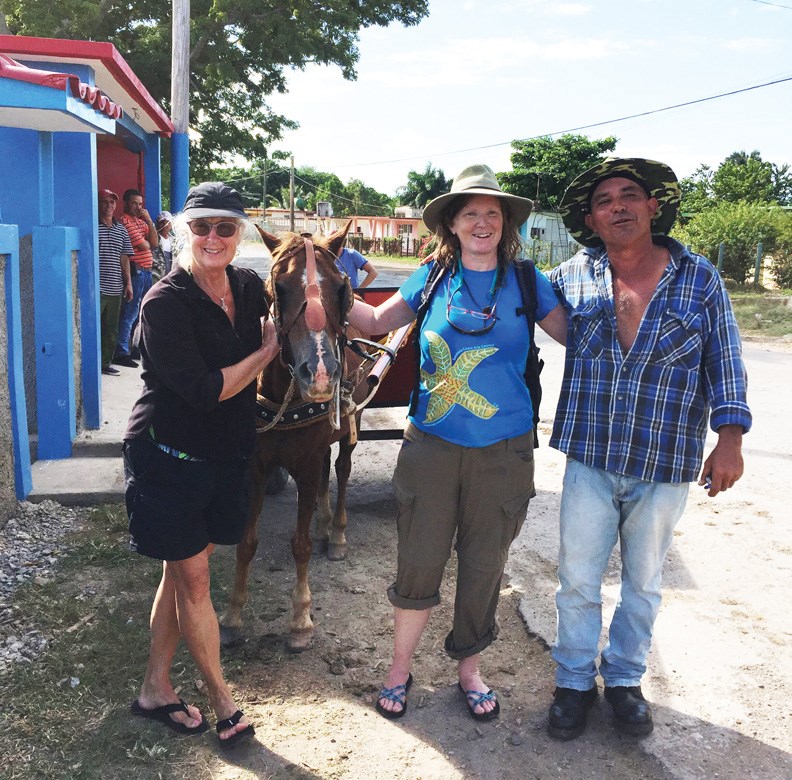My husband Frank and I are sipping a dark-rum drink called The Mafia in the lush garden lounge of the hilltop Hotel Nacional, which overlooks the city’s famed ocean boulevard, the Malecón. The drink’s name is apt: notorious mob bosses Lucky Luciano and Meyer Lansky once had separate suites in this grand, neocolonial hotel, built in 1930.
Now, in late October 2016, a peacock struts across the trim grass below tall palms. Tourists loll in large wicker chairs. Inside, in restored glory, the gleaming tiled lobby with elegant chandeliers and a high, hand-painted wooden ceiling evokes, to me, the era of grande dame hotels built by Canadian Pacific Railway along its train route.
Except this lobby displays a two-metre-high wall hanging of Fidel Castro in fatigues with 1959 printed in red: the year he overthrew corrupt president Batista and ended decades of Mafia money-laundering and decadent casinos. In this same hotel in December 1946, four mob bosses, including Luciano and Lansky, held a Mafia conference whereby Lansky allegedly ordered the hit on mobster Bugsy Siegel. Two months later, Frank Sinatra performed here to “a select group of mobsters,” according to T. J. English’s investigative book Havana Nocturne.
Cuba’s dark, 20th-century history, which metaphorically whispers “pssst” on gritty street corners next to the obvious trappings of tourism, interested me far more than Havana’s international cuisine, bus tours and tacky souvenirs. For instance, the city’s former presidential palace, built between 1913 and 1920 and decorated by Tiffany’s of New York, houses the Museo de la Revolución. Sprays of bullet holes and blood splatter high across walls and pillars are still visible: reminders of Castro’s violent ousting of Batista in January 1959, the same month and year of my birth.
This odd synchronicity with my origins has sparked my rebel spirit. Like our current prime minister, I have held a rose-coloured view of Castro until my Latin American history professor, Cubans and further readings filled me in. Yet not enough has been written on how much the U.S. government, decades before its 1960 trade embargo of Cuba, manipulated the latter’s economy with Batista’s and the Mafia’s help. Using Cuban front companies and banks, mob leaders helped forge protective tariffs for U.S. goods, quashing many of Cuba’s own exports.
Such alliances helped ensure that Cuban industries, especially sugar cane, made U.S. company owners and local landowners outrageously wealthy. For too many decades, this was Cuba’s version of the one versus 99 per cent. A Mafia man in Havana represented car companies such as General Motors and Chrysler in the 1950s — the launch of today’s finned, rebuilt beauties.
It’s no surprise that everyday Cubans, who shared in none of these riches, supported Castro’s revolutionaries. Many were appalled by Batista’s daily injustices and his campaign of torture and murder, even against boys as young as ten who delivered messages to the guerrillas.
Today, the Mafia’s casinos in Havana are gone, but historical connections to the mob remain. The Hotel Riviera, built in 1957 as a favourite hangout for gangsters, still stands on the Malecón, looking like a bland highrise. I was surprised to discover that our waterfront Hotel Copacabana, in Havana’s middle-class suburb of Miramar, was where Mafia hitman Umberto Anastasio stayed before heading to New York, where he was assassinated in a barber shop in October 1957.
Despite Castro’s nationalization of companies and the nation’s much-needed shift to free education and medical care, low pay and high prices perpetuate glaring disparities in Cubans’ wealth. In rural areas such as Santa Lucia, about 180 kilometres southwest of Havana, the impact of mining, with no environmental controls, has ruined the livelihood of some locals.
Friend Merrily and I spent an eye-opening day on a horse cart guided by Orlando, a campesino (peasant) in the Santa Lucia area, northwest of Viñales. On an otherwise scenic tour of sprawling jungle and green hilltops, we passed a black, dead river next to a sulfuric acid factory and a nearby abandoned beach, once full of Cuban fish boats and swimmers.
We rattled along wide, dusty roads built for a fenced-in gold mine that would not allow us entry. Orlando told us that the mine, partly owned by Canada and Angola, had contaminated a nearby river; any animal that drank from it died. The 45-year-old father of two, with a Grade 9 education, asked us, in Spanish, without malice: “What good is gold to me? I have no use for it. It gives me nothing.”


